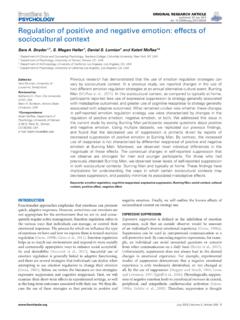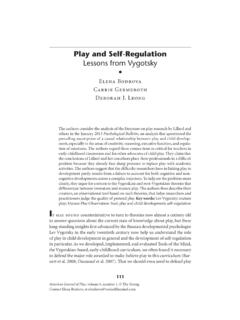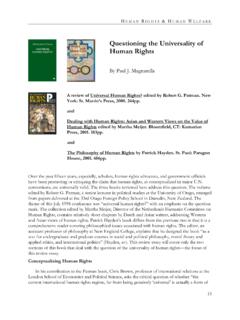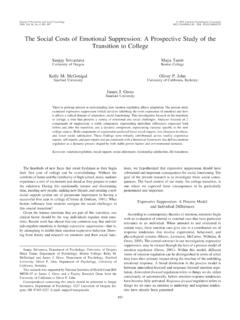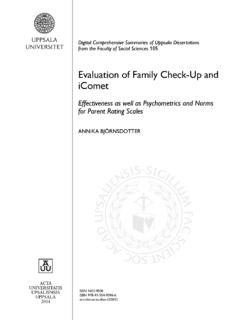Transcription of Context-Dependent Emotion Regulation: Suppression and ...
1 Context-Dependent Emotion Regulation: Suppression andReappraisal at the Burning Man FestivalKateri McRaeThe University of DenverS. Megan HellerUniversity of California, Los AngelesOliver P. JohnUniversity of California, BerkeleyJames J. GrossStanford UniversityDo people use different Emotion regulation strategies in different social contexts? Toanswer this question, we compared typical Emotion regulation use with Emotion regu-lation use at a temporary annual art festival (Burning Man). We assessed two commonemotion regulation strategies: expressive Suppression (linked to generally negative out-comes) and cognitive reappraisal (linked to generally positive outcomes). Compared totypical Emotion regulation use at home, at Burning Man participants reported decreasedsuppression use and increased reappraisal use. We consider implications for understand-ing contextual variation in Emotion regulation and discuss the properties of the BurningMan context that may facilitate this more adaptive Emotion regulation past decade has seen a surge of research investigatingthe many different strategies that individuals use toregulate emotions (Gross, 2007), but the contextualand social factors governing the use of relatively more(vs.)
2 Less) effective forms of Emotion regulation are notyet clear. To address this issue, we first review the out-comes associated with two forms of regulation and thecontexts in which their use is known to change. We thenconsider the possibility that even a temporary change insocial context might influence Emotion regulation. Inparticular, we studied the use of Suppression and reap-praisal in the social context of the weeklong BurningMan art common type of Emotion regulation isexpressivesuppression. This strategy involves inhibiting the outwarddisplay of Emotion . Experimental evidence indicates thatsuppression does not reliably reduce negative emotionalexperience (Gross, 1998; Lam, Dickerson, Zoccola, &Zaldivar, 2009) and can even lead to paradoxicalincreases in central (Goldin, McRae, Ramel, & Gross,2009), peripheral (Gross, 1998), and neuroendocrine(Lam et al.
3 , 2009) responses thought to index negativeemotion. An extension of this work is the investigationof individual differences related to the long-term orhabitual use of Suppression in everyday life. Thosewho use Suppression more frequently report lesserpositive affect, greater negative affect, diminished well-being, and a greater number of depressive symptomsthan those who use Suppression less frequently (Gross& John, 2003; Nezlek & Kuppens, 2008).A second common type of Emotion regulation iscognitive reappraisal , which involves the use of thoughtto change subsequent emotions . For example, someonecan reappraise an academic failure by thinking of itCorrespondence should be sent to Kateri McRae, Department ofPsychology, The University of Denver, 2155 South Race Street,Denver, CO 80208. E-mail: AND APPLIED SOCIAL PSYCHOLOGY, 33:346 350, 2011 Copyright#Taylor & Francis Group, LLCISSN: 0197-3533 print=1532-4834 onlineDOI: as an opportunity for growth.
4 Reappraisaldiffers from Suppression in that it targets the emotionalappraisals, or interpretations of events, that precede afull-fledged emotional response. reappraisal has beenfound to be an effective way to decrease negativeemotion, as indexed by emotional experience (Gross,1998), expressive behavior (Gross, 1998), peripheralphysiology (Jackson, Malmstadt, Larson, & Davidson,2000), and Emotion -related neural responses (Hajcak &Nieuwenhuis, 2006; Ochsner & Gross, 2008). Reapprai-sal appears to have beneficial long-term consequencesas well: The frequent use of reappraisal is associatedwith greater well-being, fewer depressive symptoms,and better interpersonal functioning (Gross & John,2003).Because expressive Suppression directly targetsoutward displays of Emotion , its use has social conse-quences, which should vary in different social in social context could be induced by (a) a tran-sition from one long-term social context to another or(b) a change to a social context that is known to be tem-porary.
5 The first of these possibilities was recently inves-tigated by a study that assessed Suppression use duringthe transition to college. After arrival at their new col-lege, freshmen used Suppression more frequently thanthey had in the last months of their high school career(Srivastava, Tamir, McGonigal, John, & Gross, 2009).However, Suppression use in a social context that is itselftemporary remains to be the present study, we measured the use of sup-pression in a temporary social context that we hypothe-sized would reduce Suppression use. In addition, wemeasured reappraisal to distinguish general changes inemotion regulation from Suppression -specific context we chose was the Burning Man Man involves the building of a temporary city(Black Rock City) for a week in an otherwise barrenNevada desert. This creates a temporary urban settingwith a population of more than 47,000 in 2007 (BurningMan Organization, 2009).
6 Ticket revenue sponsorsseveral large-scale art projects that are featured at theevent, and voluntary participant contributions in theform of gifts (art, performances, music, food, classes,goods and services) compose the rest of the Man is unlike large music festivals to which itis often compared because no mainstream musicians arehired to perform, and the event is decommericalized no selling of goods or services is permitted. We predictedreduced Suppression at Burning Man because theconsensual norms and values regarding emotionalexpression differ markedly from most Western are explicitly encouraged to engage in radical self-expression. Many individuals choose toparticipate in the festival wearing little or no clothing,decorating their bodies in colorful paint, or donning awide variety of costumes. One participant shared thisthought on an online Burning Man message board:One could say that I am free to express myself at anytime at any place but the difference is that at [BlackRock City] I can do so in a venue where the others arealso primed to receive that gift.
7 So, it has more to dowith being in a place where people feel safe expressingthemselves allowing that expression to be less inhibitedthan might be the case at home. (George, 2007)The practical limitations of this unique social contextpresented several methodological challenges to collect-ing data on the use of different Emotion regulation stra-tegies. We were restricted to the addition of single-itemmeasures to a survey administered by the Burning ManOrganization due to length concerns. Therefore, weidentified the most appropriate single items based onprevious data collected with the Emotion RegulationQuestionnaire (ERQ; Gross & John 2003). Becauseindividuals travel to Burning Man from all over theworld, we were unable to obtain an online measure ofregulation strategy use in the home context , and so weasked about the use of reappraisal and suppressionat home predicted that individuals would use suppressionless frequently in the Burning Man context .
8 Unlike theexplicit display rules relevant to Suppression , reappraisalis neither explicitly endorsed by the Burning ManOrganization nor an acknowledged aspect of partici-pation, and so we did not have strong a priori hypothesesabout differential reappraisal use at and away fromBurning Man. This was advantageous for two , we had no reason to expect that demand effectswould impact reports of reappraisal use, as reappraisalis not thought to be a commonly held value among part-icipants. Second, the pattern of reappraisal use may aidin the interpretation of the hypothesized decreased sup-pression use. If both Suppression and reappraisal arereduced at Burning Man, this is consistent with ageneralderegulationhypothesis: that participants let loose glo-bally in this social context . Another possibility is thatonly expressive Suppression is used less frequently atBurning Man than home, or thesuppression specifichypothesis.
9 This pattern would rule out the generalderegulation hypothesis, as well as potential interpreta-tions that consider a reduction of general cognitive pro-cessing required for regulation, or the possibility that theresults are due to response bias or stereotypes held aboutgenerally unregulated behavior at the event. Finally, it ispossible that the Burning Man context results in thedecrease in the use of a deleterious regulation strategylike Suppression , accompanied by an increase in the useadaptive regulation strategies such as reappraisal , ortheadaptive Emotion REGULATION347 METHODP articipantsParticipants were recruited at the Burning Man Festivalduring the week of August 27 to September 3, 2007. Insti-tutional Review Boards at The University of California,Los Angeles and Stanford University approved the collec-tion and analysis of these data. The final sample com-prised 2,558 individuals (54% male,Mage 36,SD 11).
10 MeasuresTo measure Suppression use, we used a core item of theERQ Suppression scale (Gross & John, 2003; I controlmy emotions by not expressing them ). In a separatesample (N 275), this item achieved a high correlationwith the entire Suppression scale, when asked at homeand away from home (rs .82 and .86, respectively).We reworded it slightly to read, When I want to controlmy emotions , I do so by not expressing them. To mea-sure reappraisal use, we used a core item of the ERQR eappraisal scale ( I control my emotions by changingthe way I think about a situation I m in ). In a separatesample, this item achieved a high correlation with theentire reappraisal scale when asked at home and awayfrom home (rs .75 and .79, respectively). We rewordedit slightly to read, When I want to control my emotions ,I do so by changing the way I think about the situation.
